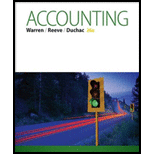
Accounting (Text Only)
26th Edition
ISBN: 9781285743615
Author: Carl Warren, James M. Reeve, Jonathan Duchac
Publisher: Cengage Learning
expand_more
expand_more
format_list_bulleted
Concept explainers
Question
Chapter 15, Problem 15.3CP
To determine
Investment: The act of allocating money to buy a monetary asset, in order to generate wealth in the future is referred to as investment.
To explain: The valuation of investments, when market value is not available
Expert Solution & Answer
Trending nowThis is a popular solution!

Students have asked these similar questions
Larson Manufacturing Company observed that, during its busiest month of 2023, maintenance costs totaled $22,400, resulting from the production of 50,000units. During its slowest month, $16,900 in maintenance costs were incurred, resulting from the production of 35,000 units. Use the high-low method to estimate the maintenance cost that the company will incur if it produces 42,000 units. (Calculation in 2 decimal)
general accounting
I need the correct answer to this financial accounting problem using the standard accounting approach.
Chapter 15 Solutions
Accounting (Text Only)
Ch. 15 - Why might a business invest cash in temporary...Ch. 15 - What causes a gain or loss on the sale of a bond...Ch. 15 - When is the equity method the appropriate...Ch. 15 - How does the accounting for a dividend received...Ch. 15 - Prob. 5DQCh. 15 - What is the major difference in the accounting for...Ch. 15 - Prob. 7DQCh. 15 - How would a debit balance in Unrealized Gain...Ch. 15 - What are the factors contributing to the trend...Ch. 15 - Prob. 10DQ
Ch. 15 - Prob. 15.1APECh. 15 - Bond investment transactions Journalize the...Ch. 15 - Prob. 15.2APECh. 15 - Stock investment transactions On September 12,...Ch. 15 - Prob. 15.3APECh. 15 - Prob. 15.3BPECh. 15 - Prob. 15.4APECh. 15 - Prob. 15.4BPECh. 15 - Prob. 15.5APECh. 15 - Prob. 15.5BPECh. 15 - Prob. 15.6APECh. 15 - Prob. 15.6BPECh. 15 - Prob. 15.1EXCh. 15 - Prob. 15.2EXCh. 15 - Prob. 15.3EXCh. 15 - Prob. 15.4EXCh. 15 - Prob. 15.5EXCh. 15 - Entries for investment in stock, receipt of...Ch. 15 - Prob. 15.7EXCh. 15 - Prob. 15.8EXCh. 15 - Entries for stock investments, dividends, and sale...Ch. 15 - Prob. 15.10EXCh. 15 - Prob. 15.11EXCh. 15 - Prob. 15.12EXCh. 15 - Prob. 15.13EXCh. 15 - Prob. 15.14EXCh. 15 - Prob. 15.15EXCh. 15 - Prob. 15.16EXCh. 15 - Fair value journal entries, trading investments...Ch. 15 - Prob. 15.18EXCh. 15 - Prob. 15.19EXCh. 15 - Prob. 15.20EXCh. 15 - Prob. 15.21EXCh. 15 - Prob. 15.22EXCh. 15 - Prob. 15.23EXCh. 15 - Prob. 15.24EXCh. 15 - Prob. 15.25EXCh. 15 - Prob. 15.26EXCh. 15 - Prob. 15.27EXCh. 15 - Prob. 15.28EXCh. 15 - Prob. 15.29EXCh. 15 - Prob. 15.1APRCh. 15 - Prob. 15.2APRCh. 15 - Stock Investment transaction, equity method and...Ch. 15 - Prob. 15.4APRCh. 15 - Prob. 15.1BPRCh. 15 - Prob. 15.2BPRCh. 15 - Stock investment transactions, equity method and...Ch. 15 - Prob. 15.4BPRCh. 15 - Selected transactions completed by Equinox...Ch. 15 - Benefits of fair value On July 16, 1998, Wyatt...Ch. 15 - International fair value accounting International...Ch. 15 - Prob. 15.3CPCh. 15 - Warren Buffett and "look-through" earnings...Ch. 15 - Prob. 15.5CP
Knowledge Booster
Learn more about
Need a deep-dive on the concept behind this application? Look no further. Learn more about this topic, accounting and related others by exploring similar questions and additional content below.Similar questions
arrow_back_ios
SEE MORE QUESTIONS
arrow_forward_ios
Recommended textbooks for you
 Auditing: A Risk Based-Approach (MindTap Course L...AccountingISBN:9781337619455Author:Karla M Johnstone, Audrey A. Gramling, Larry E. RittenbergPublisher:Cengage Learning
Auditing: A Risk Based-Approach (MindTap Course L...AccountingISBN:9781337619455Author:Karla M Johnstone, Audrey A. Gramling, Larry E. RittenbergPublisher:Cengage Learning Auditing: A Risk Based-Approach to Conducting a Q...AccountingISBN:9781305080577Author:Karla M Johnstone, Audrey A. Gramling, Larry E. RittenbergPublisher:South-Western College Pub
Auditing: A Risk Based-Approach to Conducting a Q...AccountingISBN:9781305080577Author:Karla M Johnstone, Audrey A. Gramling, Larry E. RittenbergPublisher:South-Western College Pub Cornerstones of Financial AccountingAccountingISBN:9781337690881Author:Jay Rich, Jeff JonesPublisher:Cengage LearningPrinciples of Accounting Volume 2AccountingISBN:9781947172609Author:OpenStaxPublisher:OpenStax College
Cornerstones of Financial AccountingAccountingISBN:9781337690881Author:Jay Rich, Jeff JonesPublisher:Cengage LearningPrinciples of Accounting Volume 2AccountingISBN:9781947172609Author:OpenStaxPublisher:OpenStax College

Auditing: A Risk Based-Approach (MindTap Course L...
Accounting
ISBN:9781337619455
Author:Karla M Johnstone, Audrey A. Gramling, Larry E. Rittenberg
Publisher:Cengage Learning

Auditing: A Risk Based-Approach to Conducting a Q...
Accounting
ISBN:9781305080577
Author:Karla M Johnstone, Audrey A. Gramling, Larry E. Rittenberg
Publisher:South-Western College Pub


Cornerstones of Financial Accounting
Accounting
ISBN:9781337690881
Author:Jay Rich, Jeff Jones
Publisher:Cengage Learning

Principles of Accounting Volume 2
Accounting
ISBN:9781947172609
Author:OpenStax
Publisher:OpenStax College